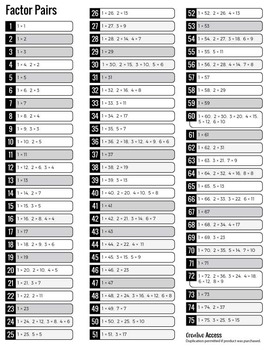Factor Pairs 1-75 Reference Sheet
Creative Access
1.5k Followers
Grade Levels
3rd - 12th
Subjects
Resource Type
Standards
CCSS4.NBT.B.6
CCSS5.NBT.B.6
CCSS3.OA.A.4
CCSS3.OA.B.6
CCSS4.OA.B.4
Formats Included
- PDF
Pages
1 page
Creative Access
1.5k Followers
Description
By the time students get to middle school, they should know all their math facts, including factors. But it doesn't always happen that way. When students don't know these basic facts, they can end up further and further behind. Many students who are capable of understanding the processes behind tougher concepts like factoring quadratics, but they get stuck because their math facts recall is holding them back. This easy-to-use reference sheet aims to help solve that problem. It lists all positive integer factor pairs for numbers 1 through 75. For example, looking up 60 reveals a list of: 1 × 60, 2 × 30, 3 × 20, 4 × 15, 5 × 12, 6 × 10.
Bonus: Prime numbers are highlighted in gray!
This sheet has been extremely helpful for my middle school students who do not have factors memorized but need to recall them quickly to participate in the general education math class. Factoring quadratic expressions (e.g., x^2 + 16x + 60) has gone from being impossible to totally doable.
Tip: If using this reference sheet to help students factor quadratic expressions, make sure the students understand the commutative property of multiplication and rules for multiplying negative integers. That is, make sure they understand that if 4 × 6 = 24, so does 6 × 4 and so does (-6) × (-4).
Bonus: Prime numbers are highlighted in gray!
This sheet has been extremely helpful for my middle school students who do not have factors memorized but need to recall them quickly to participate in the general education math class. Factoring quadratic expressions (e.g., x^2 + 16x + 60) has gone from being impossible to totally doable.
Tip: If using this reference sheet to help students factor quadratic expressions, make sure the students understand the commutative property of multiplication and rules for multiplying negative integers. That is, make sure they understand that if 4 × 6 = 24, so does 6 × 4 and so does (-6) × (-4).
Total Pages
1 page
Answer Key
N/A
Teaching Duration
N/A
Report this resource to TPT
Reported resources will be reviewed by our team. Report this resource to let us know if this resource violates TPT’s content guidelines.
Standards
to see state-specific standards (only available in the US).
CCSS4.NBT.B.6
Find whole-number quotients and remainders with up to four-digit dividends and one-digit divisors, using strategies based on place value, the properties of operations, and/or the relationship between multiplication and division. Illustrate and explain the calculation by using equations, rectangular arrays, and/or area models.
CCSS5.NBT.B.6
Find whole-number quotients of whole numbers with up to four-digit dividends and two-digit divisors, using strategies based on place value, the properties of operations, and/or the relationship between multiplication and division. Illustrate and explain the calculation by using equations, rectangular arrays, and/or area models.
CCSS3.OA.A.4
Determine the unknown whole number in a multiplication or division equation relating three whole numbers. For example, determine the unknown number that makes the equation true in each of the equations 8 × ? = 48, 5 = __ ÷ 3, 6 × 6 = ?.
CCSS3.OA.B.6
Understand division as an unknown-factor problem. For example, find 32 ÷ 8 by finding the number that makes 32 when multiplied by 8.
CCSS4.OA.B.4
Find all factor pairs for a whole number in the range 1-100. Recognize that a whole number is a multiple of each of its factors. Determine whether a given whole number in the range 1-100 is a multiple of a given one-digit number. Determine whether a given whole number in the range 1-100 is prime or composite.



